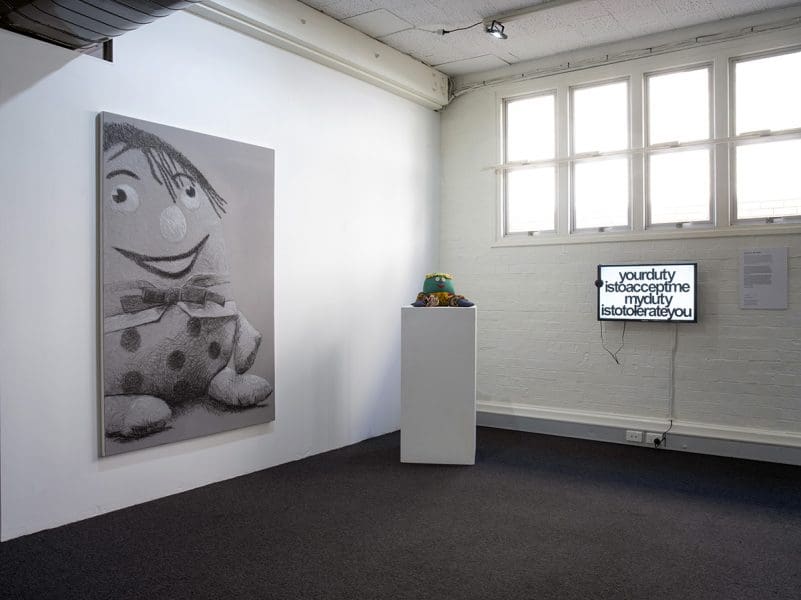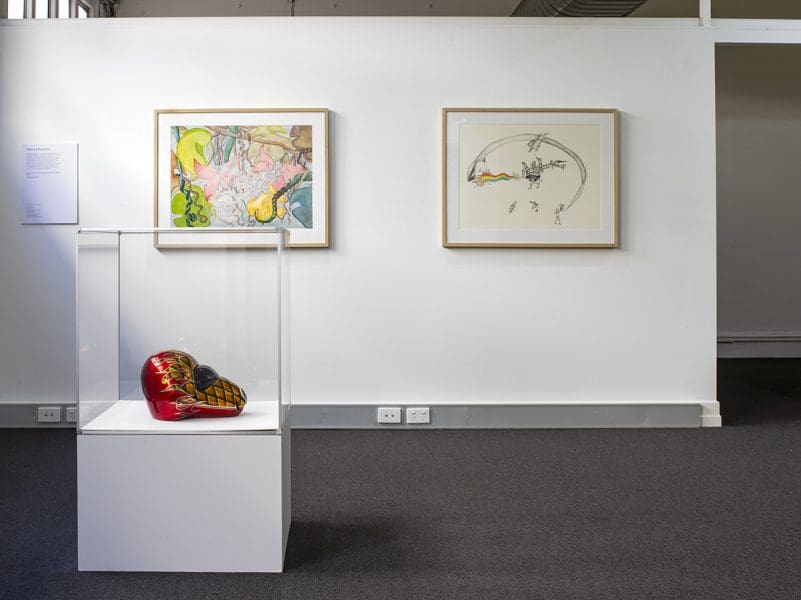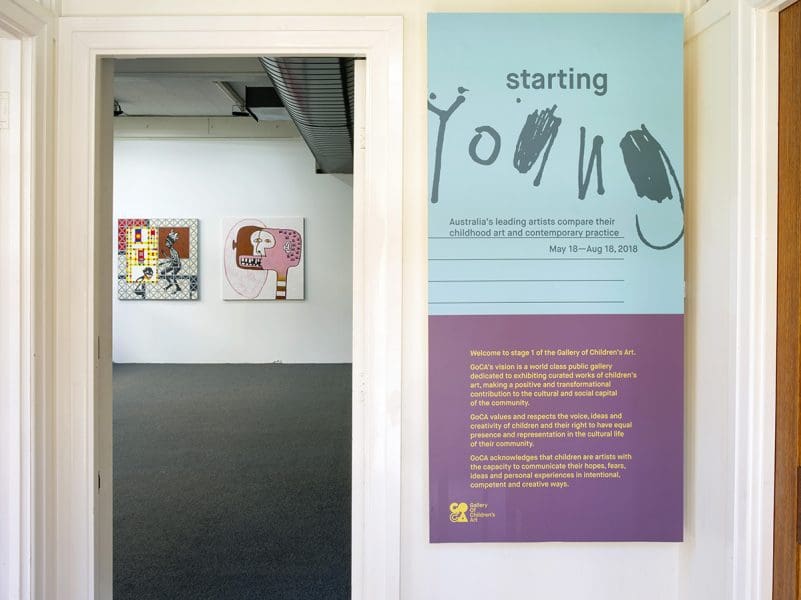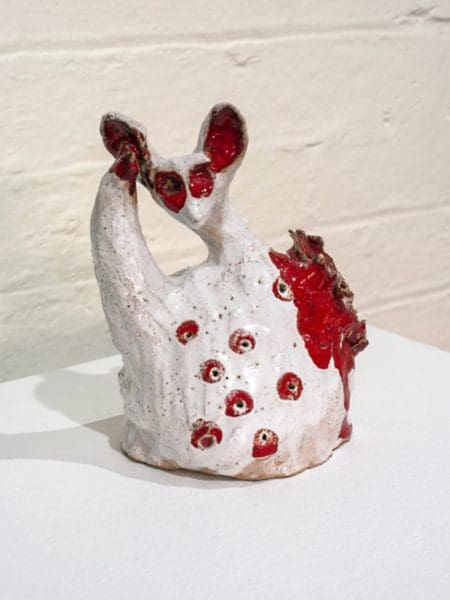
Piercing the veil
A new exhibition at Buxton Contemporary finds a rich complexity in the shadowy terrain between life and death.

Vernon Ah Kee, childhood work, date unknown, on loan from the artist. Vernon Ah Kee, Humpty Dumpty 2007, 180 x 120 cm, on loan from Milani Gallery. Video: Vernon Ah Kee talks with Daniel Browning about his art, his family, the artist group Proppa Now, and being an Aboriginal Artist, 6 December 2010, The James Sourris AM Collection, Queensland Memory Collection, State Library of Queensland, 5 minutes, 32 seconds. Installed in Starting Young at the Gallery of Children’s Art. Photo Carl Warner.

Patricia Piccinini, Untitled, 1977. Patricia Piccinini, Hothead, 2006, fibreglass and automotive paint, 30cmx 22cm x 22 cm, on loan from the Ipswich Art Gallery, Queensland. Hector Hennessy, Rainbow Abomination, 2018. Installed in Starting Young at the Gallery of Children’s Art. Photo Carl Warner.

Gordon Bennett, Untitled, circa 1968. Courtesy of the Estate of Gordon Bennett. Gordon Bennett, Home decor (Preston + De Stijl = citizen) life in the rhythm section, 1996, acrylic on linen, 100 x 100 cm. On loan from Milani Gallery. Gordon Bennett, Abstraction (Squatter), 2012, acrylic on linen, 182.5 x 152cm. On loan from Milani Gallery. Installed in Starting Young at the Gallery of Children’s Art. Photo Carl Warner.

Judy Watson, Untitled, 1977, ceramic.

Hector Hennessy, Rainbow Abomination, 2018, pencil on paper.
Dr Barbara Piscitelli AM is a leading academic and early childhood educator. She curated the first exhibition at Brisbane’s new Gallery of Children’s Art (GoCA), Starting Young. Piscitelli tells Louise Martin-Chew about her interest in art made by children. Starting Young includes work by Vernon Ah Kee, Gordon Bennett, Ross Manning, Patricia Piccinini, Luke Roberts, Madonna Staunton and Judy Watson, both from their mature practices and from their childhoods.
Louise Martin-Chew: The new Gallery of Children’s Art is your latest initiative, but your career has pivoted around a fascination with children’s art. What do you find compelling about this topic?
Barbara Piscitelli: When I began teaching in the 1970s in a childcare centre in the United States, we had a large art room which offered lots of things to explore creatively. The children could go into other areas, but they all tended to congregate in the art room. I watched them as they explored the life of ideas, graphically. I found what they made more fascinating than what they said, which explained to me something about who they were, and could not express verbally.
When I started my career as an academic I explored children’s art deeper and deeper. I found a book, Art for the Child Under Seven, by Frances Derham, mother of child art in Australia. I later started communicating with Derham and wrote my doctorate about her. I was fortunate to find opportunities and people along the way.
LMC: How long have you been working to establish the Gallery of Children’s Art?
BP: For a long time I wanted to have a place to showcase children’s ideas. I couldn’t find anybody who wanted to adopt a child-centred practice in the 1990s, so I gave up. About 2015 a group of teachers put together an exhibition in Brisbane. It was a different kind of children’s art show to the usual. Artists had worked with children artists three to five years to create a body of work. The organisers were young women who wanted a permanent home for children’s art.
The founders include Eunice Webb, principal of Ithaca Creek State School and Jess McVeigh, an art teacher, but most were early childhood teachers. Eunice brought it up at a P&C meeting one day and a parent in her community said, “I can get you a building to do proof of concept”. That building is an ARIA development site and has been given to GoCA for 18 months before they demolish it. We have worked really ambitiously with hardly any funding and much voluntary effort to prove the concept is viable.
LMC: The Gallery of Children’s Art opened on 18 May 2018. What kind of early response have you had?
BP: I was overwhelmed with the generosity of many people. Josh Milani from Milani Gallery came to us and said, “I can help you”. His assistance in getting together the six Queensland artists in the show told us that the arts community could be very interested in telling a story about how artists start young to create their ideas.
I believe that we only have one idea that we are pursuing in our lives and, if we are consistent and persistent, we will get there. In the pairing of seven artists – work from their childhood and mature work – those continuities are true. These artists started young, have developed their graphic images and ideas with more discipline and sophistication. Yet they are still pursuing those concepts today.
I have looked, but have not found any other that has shown an artist’s work from their childhood and contemporary practices side by side. I want to introduce this narrative into the discourse.
LMC: What are the drivers behind GoCA and its programs?
BP: Eunice Webb, now GoCA chair, is strongly convinced that we need to listen more to what children have to say, and to respect that. The driving motivation is to expose those ideas to the wider world in the same way as we expose adult ideas in museums and galleries.
Children are telling us from an early age about their concerns about the environment, their identity, their passions; yet there is no public platform for that discussion. It is discussed in schools and families; both are closed communities. The GoCA constitution outlines this need for public discourse about children and their ideas. Their graphic work offers an opportunity to talk about that in a public way, so the gallery can show the art and the narrative that goes with it.
LMC: Starting Young is a fascinating illustration of the Aristotelian quote, “Show me a boy at seven and I will show you the man”.
BP: As part of Starting Young I want to interview several of the artists and talk about their early arts practices so that we have documentation to enter into the literature. Many of these artists grew up in regional and remote communities without access to arts training. Theirs was a private pursuit within their family.
We want GoCA to be seen as a serious place that cares about the narrative of the artist and the passion of the collectors. The final show will be of children’s work across the state and feature primary and early childhood art. There is no other place for that work to be exhibited for public discourse. Creative Generation in Queensland allows us to talk about secondary school art, which is very well resourced in the state, but primary school art is neglected. Very few primary schools have studios or art teachers, and there is little time devoted to graphic ideas.
LMC: Can an exhibition like this change how we think about art made by youngsters?
BP: One of the most exciting things about this is the willingness of artists to talk about their early practices that are invisible. Vernon Ah Kee is astute in his understanding of how these early ideas are still ideas that he pursues. He has really invented his own way of using line to create drawings and it is quite amazing to see them come from his early explorations on his grandmother’s floor, with nothing but pen and paper. Luke Roberts was living in Alpha, aged ten, making Japanese dolls. He had extraordinary vision that he continues to pursue as part of his performance art practice.

LMC: Patricia Piccinini’s interests are visibly contained in this work from her youth, and her son’s Hector’s contribution at the same age is also intriguing. Is this another strand you might pursue?
BP: Most definitely. I really wanted a contemporary child’s work in the exhibition and Patricia offered it. Hector is an amazing artist in his own right. This intergenerational linkage is rarely explored.
LMC: Eunice Webb describes children as change agents whose role could be boosted. Can GOCA make a case for this and offer children more respect?
BP: For sure. We don’t have an opportunity to do that in our major cultural institutions – they don’t show work made by children. Within the major scientific and artistic agendas, children are not paid much attention. The Queensland Museum has a large collection of children’s toys made by Indigenous children, but that is rarely shown. Children are, from earliest childhood, who they become. Their personality, identity, message is all there and sometimes that is not comfortable. At the moment, children’s art is peripheral. GoCA is looking to bring it into the centre.
Starting Young
Gallery of Children’s Art
18 May – 18 August